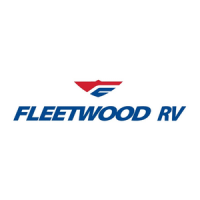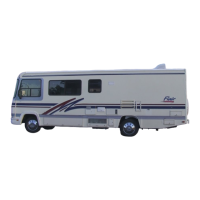Do you have a question about the Fleetwood 2004 Flair and is the answer not in the manual?
Details what the warranty covers, including structure, systems, and appliances.
Outlines the owner's responsibilities for maintenance and proper use of the RV.
Details the dealer's duties regarding predelivery inspection and repairs.
Describes the manufacturer's responsibilities for addressing warranty claims.
Lists items and conditions excluded from the warranty coverage.
Instructions on reporting safety defects to NHTSA and Fleetwood.
General safety advice covering vehicle operation and handling.
Guidelines and limitations for towing vehicles or trailers.
Importance of proper loading for safe operation and handling.
Operator's responsibility for ensuring the motor home is loaded safely.
Guidelines and weight considerations for towing vehicles or trailers.
Guidance on distributing cargo weight for safe handling and balance.
Steps to obtain individual wheel position weights for accurate load distribution.
Procedure for weighing the motor home when fully loaded.
Explains the risks and consequences of overloading the motor home.
Importance of proper tire inflation for safety, tire life, and performance.
Steps to take and safety precautions in case of a sudden tire failure.
Practical advice for safely loading items into the motor home.
Details about the cargo carrying capacity label and its components.
Steps to obtain individual axle and gross weights for proper load management.
General advice on driving techniques and vehicle control.
Information on fuel systems, including vapor pressure and cap replacement.
Safety guidelines for refueling the vehicle to prevent hazards.
Crucial safety precautions regarding carbon monoxide poisoning.
Factors affecting tire life, inflation importance, and effects of over/underinflation.
Procedures and information needed for emergency towing.
Recommendations on how often and when to check tire air pressure.
Suggestions for preventing fire incidents and actions to take if a fire occurs.
Guidance on managing interior humidity and preventing condensation.
Provides solutions for reducing moisture and eliminating condensation.
General advice and recognition of fire hazards in RVs.
Overview of the fresh water system, including city water hookup and tank filling.
Common water system problems, their causes, and solutions.
Procedure for sanitizing the fresh water tank and piping system.
Overview of the waste water system, including gray and black water tanks.
Procedure for draining black and gray water holding tanks.
Description of the 12-volt DC system for interior lights, pumps, and accessories.
Description of the 12-volt DC system for vehicle operation and controls.
How to inspect, clean, and care for the vehicle's batteries.
Methods and safety guidelines for charging the vehicle batteries.
Essential safety guidelines for operating and maintaining the generator.
Description of the 120-volt AC system for appliances and power sources.
Purpose, testing, and troubleshooting of GFCI outlets.
Operation of the generator for providing electrical power.
Essential safety precautions for handling and using LP gas.
Procedure for safely filling the LP gas tanks.
Function, testing, and placement of the LP gas leak detector/alarm.
Operation of the water heater, including safety features.
Operation and leveling requirements for the refrigerator.
Operation of the forced-air LP gas furnace.
Basic operation of the gas oven and burners.
Operation of roof-mounted air conditioners and filter maintenance.
Checklists to help prepare the motor home for storage.
Checklist of steps for preparing the RV for long-term storage.
Procedure to follow when taking the motor home out of storage.
Planning and preparation procedures for winterizing the motor home.
Detailed procedure for winterizing the RV's water system.
Details what the warranty covers, including structure, systems, and appliances.
Outlines the owner's responsibilities for maintenance and proper use of the RV.
Details the dealer's duties regarding predelivery inspection and repairs.
Describes the manufacturer's responsibilities for addressing warranty claims.
Lists items and conditions excluded from the warranty coverage.
Instructions on reporting safety defects to NHTSA and Fleetwood.
General safety advice covering vehicle operation and handling.
Guidelines and limitations for towing vehicles or trailers.
Importance of proper loading for safe operation and handling.
Operator's responsibility for ensuring the motor home is loaded safely.
Guidelines and weight considerations for towing vehicles or trailers.
Guidance on distributing cargo weight for safe handling and balance.
Steps to obtain individual wheel position weights for accurate load distribution.
Procedure for weighing the motor home when fully loaded.
Explains the risks and consequences of overloading the motor home.
Importance of proper tire inflation for safety, tire life, and performance.
Steps to take and safety precautions in case of a sudden tire failure.
Practical advice for safely loading items into the motor home.
Details about the cargo carrying capacity label and its components.
Steps to obtain individual axle and gross weights for proper load management.
General advice on driving techniques and vehicle control.
Information on fuel systems, including vapor pressure and cap replacement.
Safety guidelines for refueling the vehicle to prevent hazards.
Crucial safety precautions regarding carbon monoxide poisoning.
Factors affecting tire life, inflation importance, and effects of over/underinflation.
Procedures and information needed for emergency towing.
Recommendations on how often and when to check tire air pressure.
Suggestions for preventing fire incidents and actions to take if a fire occurs.
Guidance on managing interior humidity and preventing condensation.
Provides solutions for reducing moisture and eliminating condensation.
General advice and recognition of fire hazards in RVs.
Overview of the fresh water system, including city water hookup and tank filling.
Common water system problems, their causes, and solutions.
Procedure for sanitizing the fresh water tank and piping system.
Overview of the waste water system, including gray and black water tanks.
Procedure for draining black and gray water holding tanks.
Description of the 12-volt DC system for interior lights, pumps, and accessories.
Description of the 12-volt DC system for vehicle operation and controls.
How to inspect, clean, and care for the vehicle's batteries.
Methods and safety guidelines for charging the vehicle batteries.
Essential safety guidelines for operating and maintaining the generator.
Description of the 120-volt AC system for appliances and power sources.
Purpose, testing, and troubleshooting of GFCI outlets.
Operation of the generator for providing electrical power.
Essential safety precautions for handling and using LP gas.
Procedure for safely filling the LP gas tanks.
Function, testing, and placement of the LP gas leak detector/alarm.
Operation of the water heater, including safety features.
Operation and leveling requirements for the refrigerator.
Operation of the forced-air LP gas furnace.
Basic operation of the gas oven and burners.
Operation of roof-mounted air conditioners and filter maintenance.
Checklists to help prepare the motor home for storage.
Checklist of steps for preparing the RV for long-term storage.
Procedure to follow when taking the motor home out of storage.
Planning and preparation procedures for winterizing the motor home.
Detailed procedure for winterizing the RV's water system.
| Model Year | 2004 |
|---|---|
| Make | Fleetwood |
| Model | Flair |
| Width | 8.5 feet |
| Fuel Type | Gasoline |
| Sleeping Capacity | 6 |
| Slide-Outs | 1 |
| Chassis | Ford |
| GCWR | 26, 000 lbs |
| Engine | V10 |
| Generator | Onan 5.5 kW |











